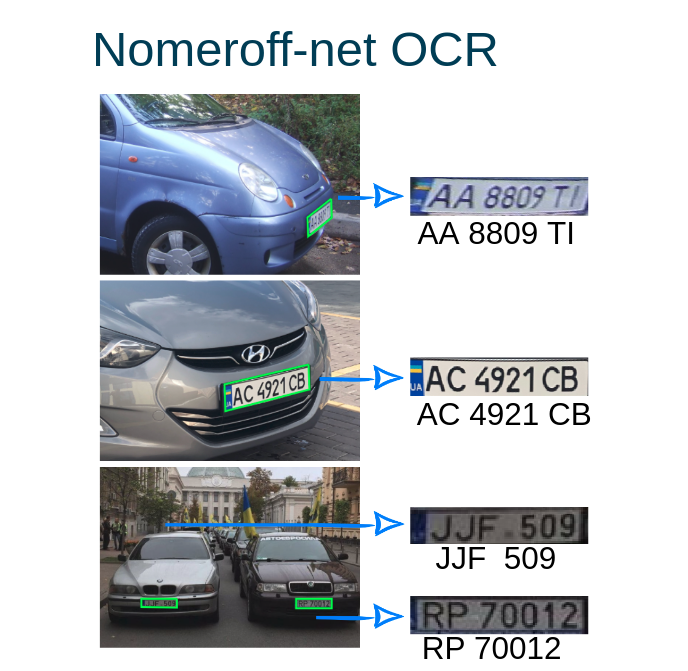Nomeroff Net. Automatic numberplate recognition system. Version 2.4
Nomeroff Net is an opensource python license plate recognition framework based on YOLOv5 and CRAFT networks and customized OCR-module powered by RNN architecture.
The project is now at the stage of development, write to us if you are interested in helping us in the formation of a dataset for your country.
Version 2.4 is completely rewritten to PyTorch. Change History.
Nomeroff Net requires Python >= 3.6
Clone Project
git clone https://github.com/ria-com/nomeroff-net.git
cd nomeroff-net# for Opencv
yum install libSM
# for pycocotools install
yum install python3-devel
# ensure that you have installed gcc compiler
yum install gcc
yum install git
# Before "yum install ..." download https://libjpeg-turbo.org/pmwiki/uploads/Downloads/libjpeg-turbo.repo to /etc/yum.repos.d/
yum install libjpeg-turbo-officialinstall requirements:
pip3 install -r requirements.txt # ensure that you have installed gcc compiler
apt-get install gcc
# for opencv install
apt-get install -y libglib2.0
apt-get install -y libgl1-mesa-glx
# for pycocotools install (Check the name of the dev-package for your python3)
apt-get install python3.6-dev
# other packages
apt-get install -y git
apt-get install -y libturbojpeginstall requirements:
pip3 install -r requirements.txt # Specify device
import os
# Specify device
os.environ["CUDA_VISIBLE_DEVICES"] = "0"
# Import all necessary libraries.
import sys
import cv2
# NomeroffNet path
NOMEROFF_NET_DIR = os.path.abspath('../')
sys.path.append(NOMEROFF_NET_DIR)
# Import license plate recognition tools.
from NomeroffNet.YoloV5Detector import Detector
detector = Detector()
detector.load()
from NomeroffNet.BBoxNpPoints import NpPointsCraft, getCvZoneRGB, convertCvZonesRGBtoBGR, reshapePoints
npPointsCraft = NpPointsCraft()
npPointsCraft.load()
from NomeroffNet.OptionsDetector import OptionsDetector
from NomeroffNet.TextDetectors.eu import eu
from NomeroffNet import textPostprocessing
# load models
optionsDetector = OptionsDetector()
optionsDetector.load("latest")
textDetector = eu
textDetector.load("latest")
# Detect numberplate
img_path = 'images/example2.jpeg'
img = cv2.imread(img_path)
img = cv2.cvtColor(img, cv2.COLOR_BGR2RGB)
targetBoxes = detector.detect_bbox(img)
all_points = npPointsCraft.detect(img, targetBoxes,[5,2,0])
# cut zones
zones = convertCvZonesRGBtoBGR([getCvZoneRGB(img, reshapePoints(rect, 1)) for rect in all_points])
# predict zones attributes
regionIds, countLines = optionsDetector.predict(zones)
regionNames = optionsDetector.getRegionLabels(regionIds)
# find text with postprocessing by standart
textArr = textDetector.predict(zones)
textArr = textPostprocessing(textArr, regionNames)
print(textArr)
# ['JJF509', 'RP70012']Note: This example disables some important Nomeroff Net features. It will recognize numbers that are photographed in a horizontal position.
import os
# Specify device
os.environ["CUDA_VISIBLE_DEVICES"] = "0"
# Import all necessary libraries.
import sys
import cv2
# NomeroffNet path
NOMEROFF_NET_DIR = os.path.abspath('../')
sys.path.append(NOMEROFF_NET_DIR)
# Import license plate recognition tools.
from NomeroffNet.YoloV5Detector import Detector
detector = Detector()
detector.load()
from NomeroffNet.TextDetectors.eu import eu
from NomeroffNet import textPostprocessing
textDetector = eu
textDetector.load("latest")
# Detect numberplate
img_path = 'images/example2.jpeg'
img = cv2.imread(img_path)
img = cv2.cvtColor(img, cv2.COLOR_BGR2RGB)
targetBoxes = detector.detect_bbox(img)
zones = []
regionNames = []
for targetBox in targetBoxes:
x = int(min(targetBox[0], targetBox[2]))
w = int(abs(targetBox[2]-targetBox[0]))
y = int(min(targetBox[1], targetBox[3]))
h = int(abs(targetBox[3]-targetBox[1]))
image_part = img[y:y + h, x:x + w]
zones.append(image_part)
regionNames.append('eu')
# find text with postprocessing by standart
textArr = textDetector.predict(zones)
textArr = textPostprocessing(textArr, regionNames)
print(textArr)
# ['RP70012', 'JJF509']In order to evaluate the quality of work of Nomeroff Net without spending time on setting up and installing, we made an online form in which you can upload your photo and get the recognition result online
All data on the basis of which the training was conducted is provided by RIA.com. In the following, we will call this data the AUTO.RIA Numberplate Dataset.
We will be grateful for your help in the formation and layout of the dataset with the image of the license plates of your country. For markup, we recommend using VGG Image Annotator (VIA)
The system uses several neural networks. One of them is the classifier of numbers at the post-processing stage. It uses dataset AUTO.RIA Numberplate Options Dataset.
The categorizer accurately (99%) determines the country and the type of license plate. Please note that now the classifier is configured mainly for the definition of Ukrainian numbers, for other countries it will be necessary to train the classifier with new data.
As OCR, we use a specialized implementation of a neural network with RNN layers, for which we have created several datasets:
- AUTO.RIA Numberplate OCR UA Dataset (Ukrainian)
- AUTO.RIA Numberplate OCR UA Dataset (Ukrainian) with old design Dataset
- AUTO.RIA Numberplate OCR EU Dataset (European)
- AUTO.RIA Numberplate OCR RU Dataset (Russian)
- AUTO.RIA Numberplate OCR KZ Dataset (Kazakh)
- AUTO.RIA Numberplate OCR GE Dataset (Georgian)
- AUTO.RIA Numberplate OCR BY Dataset (Belarus)
- AUTO.RIA Numberplate OCR SU Dataset (exUSSR)
- AUTO.RIA Numberplate OCR KG Dataset (Kyrgyzstan)
- AUTO.RIA Numberplate OCR AM Dataset (Armenia)
If we did not manage to update the link on dataset you can find the latest version here
This gives you the opportunity to get 99% accuracyon photos that are uploaded to AUTO.RIA project
Contributions to this repository are welcome. Examples of things you can contribute:
- Training on other datasets.
- Accuracy Improvements.
- Dmytro Probachay <dmytro.probachay@ria.com>
- Oleg Cherniy <oleg.cherniy@ria.com>



